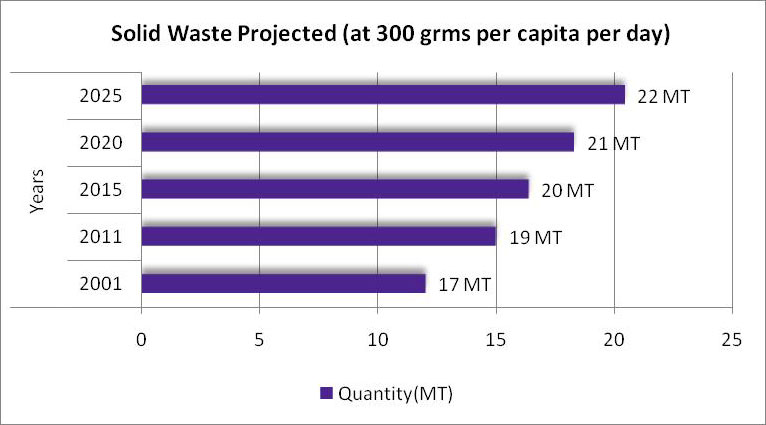The Municipalities within the region are facing huge problems regarding their various Infrastructural services. In the last century up to 70’s the amount of solid wastes generated in this Municipal area were simply thrown in the nearby places. The type of these wastes are mainly Organic i.e. easily degradable.
However, gradually with the increase in population, the quantity of generated wastes increased at an alarming rate. With it came the non- biodegradable materials like plastics since 1980. To keep the environment clean, vats at different locations, dustbins, handcarts etc. came into existence. People objected this system of vats as those created environmental nuisance in case of irregular clearance. Municipality is planning to collect waste from doorsteps and directly dumped in the landfill site. There is huge need for a proper dumping ground.
Asset Category |
Quantity/ Capacity |
Year of Construction/ Commissioning |
Physical Condition/ State of Repairs |
|||
Solid Waste Management |
||||||
Collection vehicles, bins/ containers |
Type |
Capacity |
No. |
Year of Commissioning |
State of Repairs |
|
Conservancy Tractor with Trailor |
Ford |
1 MT |
2 |
1960 |
One Working |
|
Conservancy Truck |
Tata |
2 MT |
1 |
1990 |
Good Condition |
|
Jeep Trailer |
Tata |
0.5 MT |
1 |
2004 |
Good Condition |
|
Dustbins |
Cement |
8 Tons |
74 |
- |
Good Condition |
|
Central Septic Tank |
Cemented |
|
1 |
- |
Good Condition |
|
Public Latrines |
Septic |
200 Seats |
18 |
- |
Good Condition |
|
Community latrines |
Septic |
|
32 |
- |
Good Condition |
|
Composting plant, if any |
Rated vs. actual capacity |
Year of Commissioning |
State of Repairs |
|||
Land fill site |
Location |
Size |
No. of years in use |
|
||
Dumping ground |
Near Polytechnic College |
1 No. |
24 years |
Leased |
||
Solid Waste Generation
The type of waste generated within the municipal areas can be largely classified as
(i) MSW (Municipal Solid Wastes):- These include Organic & Inorganic Wastes, to be handled by the Municipality.
(ii) Biomedical Wastes- These are wastes from Nursing Homes etc. Agency authorized West Bengal Pollution Control Board, may be appointed to handle these wastes
(iii) Industrial Wastes - No significant industrial waste is generated.
(iv) Construction and Demolition Wastes - These have not created any problem till now and they are mainly used for filling up of low-lying areas.
Collection & Transportation system: Presently waste is disposed off in the community vats nearby. From there it was collected by cycle vans, then trailers and finally was taken to Dumping Ground by these Trailers.
In the Municipal Area, at present, the collection is generally done by 2 methods:-
- Waste collection from vats by the Municipality
- Collection from Drain sludge / jungle by Municipal own measures.
The collected wastes in both the cases are directly transported to the disposal ground.
But the door to door collection system and segregation of wastes at the source is yet to be established fully. The door-to-door system of waste collection exists partially.
Disposal System and Treatment:
No treatment of waste is been attempted as yet. With the increase in generation of waste the area of the site is inadequate. The municipality is contemplating to buy land preferably outside the municipal area as there is no land available within its limits.
The main problem that has been faced by the people of Kurseong is the disposal of solid wastes. Municipality does not have proper disposal site with latest technology. The daily volume of solid wastes is about 6 M.T. but these wastages is directly disposed of into Jhoras (Big Nullaha) without any grading & treatment causing blockage of Jhoras during rainy season and damaging the tea bushes & houses of B.P.L. families due to heavy flow of water in the Jhora. At present the Municipality has about 65 nos. of Conservancy Staff who look after both the liquid waste system & manage to dispose of the solid waste and only two nos. of Tractors to lift this garbage by head load which is not feasible to manage to keep the town clean due to difficult topography of Kurseong. Hence, the problem can be solved if proper site for disposal of solid waste with latest technology are developed in near future.
The new Board of Councillors has awoken to the necessity of having solid waste management and identified fallow land at Spring side Tea Garden. The land is about 3 kilometers from the main town and far from the populated area. The Municipality has prepared a project for solid waste management in this land. The garbage collected from the houses will be transported in trucks to the above site and separated into bio degradable and non degradable items. After segregation the items will be treated so that compost prepared from the items could be used as fertilizer. The tea gardens of the neighboring areas have shown keen interest in purchasing the compost so prepared for use in the tea garden.
In Kurseong Municipality, the quantity of solid waste generated per capita per day was 75 grams. The quantity of solid waste generated per day was 6 Metric Tons.
As per UDPFI Guidelines, the generation of waste varies from about a quarter of kilogram in small towns to about half a kilogram per capita in large and metro cities.
Solid Waste Generation projection
The waste projection for 2025 of Kurseong Municipality has also been estimated assuming the quantity of generation as 300 gms per capita per day, as per UDPFI Guideline and considering the strong potential for growth of the Municipal area.
Figure 03, Solid Waste Generation Projection

